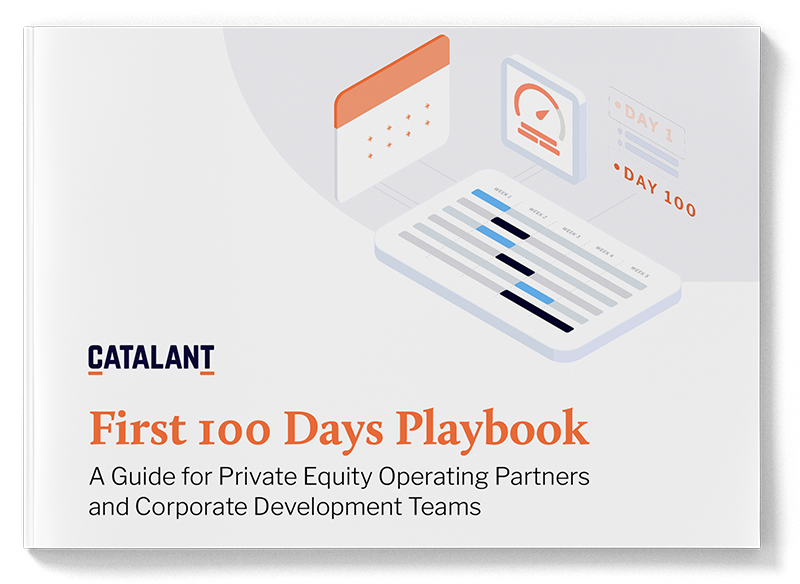“Change” Communication in Post-M&A Integration: The First 100 Days

This article is part of the latest issue of the Catalant Quarterly: “The ‘First 100 Days’ Strategy: A Blueprint for Accelerated Value Creation.” Read the issue here and download the First 100 Days Playbook.
M&A is on the rise, driven by heightened corporate clarity, restructuring, strategic imperatives like digital transformation, and opportunity. Whatever the driver, these deals create change, and managing change requires mastering strategic change communication. The first 100 days post-M&A are pivotal, setting the tone for the future of the integrated entities.
This article introduces the indispensable importance of leadership communication in M&A, and offers best practices for engaging stakeholders, addressing common pitfalls, and navigating this transformative period successfully.
Decisive Leadership: The Foundation of Effective Communication
Successful post-M&A integration requires decisive leadership from the CEO and executive team. Whether a merger or acquisition, the nature of the transaction profoundly influences the integration strategy and, consequently, both what and how to communicate. Ambiguity in leadership intentions and decisions leads to widespread uncertainty, affecting subsequent decisions and actions, and undermining trust and commitment throughout the organization. Indecision breeds a culture of hesitation and inconsistency, resulting in disjointed integration efforts.
The CEO and Executive Team: Setting the Tone
The identity of the post-M&A relationship, whether a merger of equals or an acquisition, forms the bedrock of subsequent communication initiatives. A definitive stance minimizes doubt and confusion, enabling leaders at all levels to engage their teams, stakeholders, and the broader market with confidence and consistency.
Communication strategies are best aligned with the nature of the integration.
- In a merger the emphasis is on partnership, fostering a collaborative atmosphere.
- An acquisition should focus on the benefits of the new relationship for all parties.
- In “compassionate” acquisitions, the priority shifts to preserving the acquired company’s values and way of working.
Here are examples of key messages to help establish the foundation for your communication efforts.
Table 1 – Integration Type Communication Grid
Integration Type
Merger
Communication Focus
Partnership & Equality
Key Messages
- Emphasize the coming together of equals to create a stronger entity.
- Highlight shared goals and the vision for the future.
- Collaborate on the merging of cultures and the creation of a new, unified culture.
Integration Type
Acquisition
Communication Focus
Strategic Advantages & Future Direction
Key Messages
- Outline the strategic benefits of the acquisition for all stakeholders.
- Clarify changes in leadership and operational structures.
- Reassure employees and stakeholders about the integration process and job security.
Integration Type
Compassionate Acquisition
Communication Focus
Preservation & Integration
Key Messages
- Stress the value of the acquired company’s legacy and commitment to preserving its core values.
- Communicate the steps taken to integrate employees compassionately.
- Ensure transparency about any changes while emphasizing respect for the existing culture and practices.
Strategic M&A Communication Examples
Disney and Pixar Merger: A prime example of effective cultural integration and strategic communication, maintaining a unified message about future goals and cultural respect.
Microsoft and LinkedIn Acquisition: Demonstrates the importance of upfront communication about operational autonomy and mutual benefits, easing stakeholder concerns.
Key Stakeholder Communication in the First 100 Days
The first 100 days post-M&A must establish trust, provide clarity, and generate momentum. Communication with key stakeholders—employees, customers, investors, and regulatory bodies—must be meticulously planned and executed.
Effective communication begins on Day One, but the plan must be established beforehand, because this is often a frenetic time dealing with stakeholders’ concerns about the impact to the status quo. To lay a strong foundation, start planning communication strategies at the end of the due diligence phase and continue refining these throughout the post-M&A integration lifecycle. Employing a structured communication approach that encompasses top-down, across, and bottom-up methods is the best approach.
Here are some of the common pitfalls and best practices for seamless communication throughout this transformative period.
Common Pitfalls in Post-M&A Communication
1. Lack of Clear Decision-Making
A significant pitfall is indecisive leadership from the CEO and executive team. When leaders fail to promptly and clearly define the nature of the M&A and the plan forward, it creates uncertainty which typically manifests in inconsistent messages from different leaders, wasted time and effort, additional cost, duplicative or conflicting actions, and the erosion of trust.
2. Over-Reliance on Communication without Action
Another common mistake is focusing exclusively on communication for change management. Communication must be backed by tangible actions and a clear roadmap for integration. Without the accompanying action, communication is perceived as hollow, leading to skepticism and resistance to change.
3. Underestimating Cultural Integration
Underplaying the importance of cultural integration is a critical oversight. Post-M&A, organizations often emphasize technical and operational integration, neglecting the profound impact of cultural differences. This oversight leads to a clash of corporate cultures, creating friction and hindering the unified vision’s realization.
4. Inadequate Stakeholder Engagement
Failing to comprehensively engage all relevant stakeholders is a frequent misstep. Inadequate engagement with customers, suppliers and other stakeholders leads to overlooked concerns, unaddressed issues, and less engaged stakeholders. This is especially important if systems or process changes impact how stakeholders have previously engaged with the new organization.
5. Neglecting Individual Concerns
A one-size-fits-all approach to communication falls short of addressing the varied concerns and questions of different stakeholder groups. Personalized communication that addresses “their” concerns can significantly enhance trust and cooperation during the integration process.
Best Practices for Internal and External Communications
When communicating change, especially operational changes, to internal and external stakeholders, it’s essential to not only outline the what and the when, but also the why. This transparency helps manage expectations and reduces resistance to change.
I recommend coordinating post-M&A activities within a dedicated Integration Management Office (IMO). This central hub orchestrates work streams, timelines, and resources, ensuring that strategic decisions are effectively translated into actionable plans with structured communication as part of it.
Internal Communications: Transparency and regular updates about changes in processes, systems (such as ERP integrations), and organizational structure are crucial. Ongoing communication addresses both identity and direction to every team member.
- Establish a Clear Narrative: From day one, communicate a clear and compelling narrative that outlines the vision, purpose, and expected benefits of change. This starts with executive leadership. The narrative should be consistently echoed by all leaders and tailored for different internal audiences.
- Foster Open Dialogue: Create platforms and forums for employees to ask questions and provide feedback. This demonstrates respect for employees and helps identify concerns early-on. Frequent pulse-check surveys, physical or virtual comment boxes, and town hall meetings all help.
- Cultural Integration Workshops: Workshops and team-building activities promote understanding of the merging organizations’ cultures. These initiatives help in building relationships and encourage a cohesive culture for the new entity.
External Communications: Engaging with customers, particularly key customers, and the market overall is vital. Clear messaging enhances understanding and value for customers, addresses potential concerns, and helps to retain key relationships.
- Market-Focused Messaging: Clearly articulate the benefits to customers, focusing on how it will enhance the relationship. Ensure internal team members are up to speed on messaging because much market interaction takes place in informal, peer-to-peer channels.
- Engage Key Customers Early: Identify and engage key customers and stakeholders early. Personal calls by senior executives provide reassurance during the transition.
- Transparent and Timely Updates: Regularly update external stakeholders on progress including any changes that directly affect them. Transparency builds trust and mitigates the risk of speculation and uncertainty.
Underpinning it all is a robust change management strategy. The success of communication programs is deeply connected to change management. This change management strategy must include clear, decisive executive sponsorship actions, a unified vision, a thorough understanding of the required cultural and operational shifts, a stakeholder engagement and communication plan, and more.
Why does this matter? Communication devoid of this foundation becomes hollow, failing to inspire action or commitment to the new entity’s vision. We’ve all seen it happen: great initial communication followed by months of silence—no follow-up, no feedback, no tangible results. Avoid this by implementing strategic change management that ensures robust stakeholder engagement and maintains active feedback loops.
Five Actionable Takeaways
Ensure Decisivie Leadership
Clarity from the top is non-negotiable for effective communication. Decide on your integration type.
Embed Communications in Strategic Change Management
Communication should be part of a broader change management strategy. Appoint a dedicated strategic change leader to anchor and drive these efforts.
Prioritize Cultural Integration
Allocate resources and time to bridge cultural divides. With your strategic change lead, develop a culture blueprint focused on sharing the values needed to integrate – don’t boil the ocean while avoiding the pitfalls of a superficial merger.
Engage Stakeholders Effectively
Tailor communication strategies to different stakeholder groups. Meet with teams an make them feel valued and integral to the future.
Utilize an IMO for Coordination
Establish an Integration Management Office (IMO) to effectively coordinate and manage all integration activities. Positioning change management within the IMO enhances operational efficiency and communication flow, ensuring strategic alignment and clarity throughout the organization.
In leveraging the strategies outlined here, PE and corporate executives can expect not only to manage change more effectively but also to drive substantial value creation, positioning their organizations advantageously in an increasingly uncertain global market.

Download the First 100 Days Playbook
Learn more about why the first 100 days after a transaction so important.
Meet the Author

Niki St. Pierre is a seasoned organizational change strategist, practitioner, and a recognized voice on business integration and transformation. Based in Chicago, IL, she is a Forbes contributor and has been honored by LinkedIn as a “Top Voice in Change Management.” With over 20 years of experience, ex-Accenture, Niki partners with executives across Fortune 500 companies, middle-market firms, and the public sector to navigate complex disruptions, fostering environments ripe for innovation, collaboration, and resilience. As the managing partner of NSP & Company, where she leads a team of experts, many formerly from big-four consulting firms, Niki excels in driving readiness and communication that accelerate change adoption, expediting value realization. A proponent of agile, lean, and human-centered methodologies, Niki guides organizations in embracing change confidently. She holds an MPA/MBA degree from NYU.